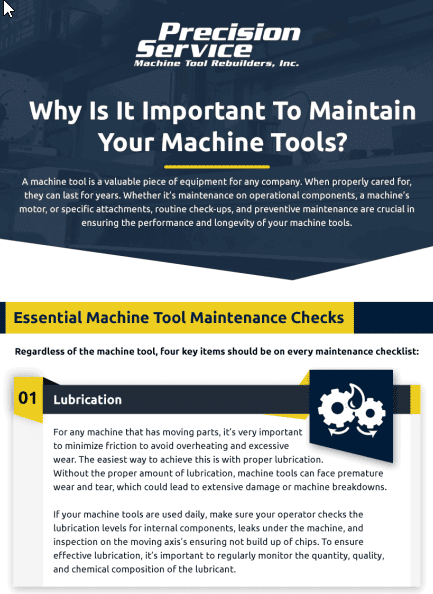- 1-800-4-REBUILD
- admin@precisionservicemtr.com
- 121 W. Fullerton Avenue Addison, IL 60101
WHY IS IT IMPORTANT TO MAINTAIN YOUR MACHINE TOOLS?
A machine tool is a valuable piece of equipment for any company. When properly cared for, they can last for years; however, neglected machine tools can lead to costly repairs, downtime,. Whether it’s maintenance on operational components, a machine’s motor, or specific attachments, routine check-ups and preventive maintenance are crucial in ensuring the performance and longevity of your machine tools.
- See More Below!
ESSENTIAL MACHINE TOOL MAINTENANCE CHECKS
Regardless of the machine tool, four key items should be on every maintenance checklist: lubrication, calibration, cleaning, and accessory management.
Lubrication
For any machine that has moving parts, it’s very important to minimize friction to avoid overheating and excessive wear. The easiest way to achieve this is with proper lubrication. This includes visually inspecting all moving parts and applying the correct amount of grease, oil, or other lubricant. Without the proper amount of lubrication, machine tools can face premature wear and tear, which could lead to extensive damage or machine breakdowns. If your machine tools are used daily, make sure your operator checks the lubrication levels for internal components, leaks under the machine, and inspection on the moving axis’s ensuring not build up of chips. To further ensure effective lubrication, it’s important to regularly monitor the quantity, quality, and chemical composition of the lubricant.Calibration
When a machine tool is initially installed, it should function within a particular set of manufacturing tolerances. However, using machines over time is bound to cause steady displacement from these specifications. Common causes of displacement include:- Unavoidable wear and tear
- Operator mistake or misuse
- Extensive operation in an extreme environment, such as high temperatures or high humidity
Cleaning
The cleanliness of a machine tool is often overlooked when it comes to breakdowns. However, neglecting this step can lead to major issues. Repetitive cutting and grinding operations cause material chips and dust to build up, especially in hard-to-reach places within the machine. The build-up of debris can interfere with operations, cause unnecessary wear and tear, and even pose a threat to worker safety. Keeping good machine hygiene is especially important when working with flammable or hazardous materials. Some parts of the machine can be easily cleaned with a rag and degreaser. Other parts may be time-consuming and require some disassembly with specialized tools. In any case, it is important to understand the functional requirements of your machine tool before attempting to clean it.Accessory and Parts Management
Having the proper spare parts and accessories on hand is crucial to ensuring the effectiveness of your maintenance program. Lacking these items can hinder your overall maintenance tasks and prolong machine tool downtimes. To avoid this, the maintenance planner should take note of which parts and accessories are critical for machine tool operation and decide on the appropriate stock level. These parts should be properly handled and stored to ensure they remain in good condition for when they are needed.Formulate Your Machine Maintenance Strategy
Preventive maintenance is important in ensuring that you will get the most out of your machine tool. When determining the proper frequency of preventative maintenance for your machine tool, you can take one of the following approaches:
- Time-based approach. A time-based approach schedules preventative maintenance tasks based on a set time frame. For example, you could choose to perform preventative maintenance every 10 days.
- Usage-based approach. With a usage-based approach, preventative maintenance is conducted when machine tool usage hits a particular benchmark.
- Condition-based approach. This approach is the most proactive, as it monitors the actual condition of the machine tool to determine which particular maintenance tasks are required.
Depending on the machine tool and operations, these strategies can be used independently or in conjunction with one another.
When It's Time for a Machine Repair or Rebuild
Even with proper maintenance, repairs or rebuilds of your machine tool will become inevitable over time. While a good maintenance regimen can make a machine and its critical parts last longer, it won’t make the machine tool indestructible. When considering if a machine should be repaired or replaced, certain factors should be considered.
Repairs are often the best choice if the machine tool is still under warranty, you still have payments to make, only one or two components require service, or you need the equipment quickly. Repairs can be conducted on-site, offering faster completion times than rebuilds or replacements.
Although repair services provide a quicker way to improve equipment longevity, it is not always the best option. For example, if you are using an outdated or discontinued machine tool, finding replacement parts can be very difficult. If you are having several issues with your machine tool, rebuilds can be a better choice than repairs. With a rebuild, more systems can be restored or replaced while also upgrading the performance and appearance of your machine tool.
Work With Precision Service Machine Tool Rebuilders
Precision Service MTR has over 30 years of experience with repairing and rebuilding machining tools. Over the decades, we have become a trusted name in the machining industry, providing customers with quality onsite repair, custom rebuilding, and many more beneficial services. At Precision Service MTR, we are committed to customer satisfaction, and we strive to help businesses keep their machines in optimal working condition. To learn more about our services and how we can benefit your maintenance program, contact us today.

